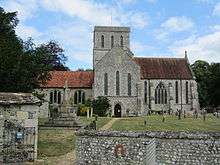Amesbury Abbey

Amesbury Abbey was a Benedictine abbey at Amesbury in Wiltshire, England, founded by Queen Ælfthryth in about the year 979 on what may have been the site of an earlier monastery. The foundation was dissolved in 1177.
The abbey church has survived as the Church of St Mary and St Melor, a Grade I listed building.[1] The name Amesbury Abbey is now used by a nearby mansion, which has since been converted into a nursing home. This house is also Grade I listed.[2]
History
Ælfthryth founded two religious houses at about the same time, the other being at Wherwell in Hampshire. Her motive was long believed to be contrition for the murder of Edward the Martyr, making the date of 979 given by the Melrose chronicle appropriate. However, she is now considered not to have been personally responsible for the murder.[3]
Amesbury was already a sacred place in Pagan times, and there are legends that a monastery existed there before the Danish invasions. There may have been an existing cult of St Melor which led Ælfthryth to choose Amesbury. Melor, the son of a leader of Cornouaille and a boy-martyr, was buried at Lanmeur and venerated in Brittany, but a later tradition claims that some of his relics were brought to Amesbury and sold to the abbess. Edward was another boy-martyr. However, the 12th-century life of St Melor says the nunnery at Amesbury was founded before Melor's relics arrived.[3] At the time of the Domesday Book (1086), the abbey held, as it had in King Edward's time, the Wiltshire manors of Bulford, Boscombe, Allentone, Choulston, and Maddington, totalling twenty-seven hides, plus the manor of Rabson in Winterbourne Bassett. In Berkshire it held Ceveslane in Challow, Fawley, and Kintbury and the church at Letcombe Regis.[3]
In 1177 Ælfthryth's foundation was dissolved by Henry II and its buildings used for the foundation of a double priory of the Fontevrault order.[4][5] Eleanor of Brittany, the princess held captive for most of her life, donated her body here, and later King Henry III would donate a manor of Melksham to the abbey as well for the souls of her and her brother Arthur, who was widely believed to be murdered by King John; Eleanor of Provence, queen of England, was buried in the abbey on 11 September 1291. It seems likely that the church of the abbey became the parish church, and this may explain why it was spared at the time of the Dissolution of the Monasteries, when the priory and its other buildings were destroyed. The Amesbury estate was subsequently granted to Edward Seymour, 1st Earl of Hertford, by the Crown.[6]
Present day Amesbury Abbey
The nearby country house, also called Amesbury Abbey, stands in 35 acres of parkland[7] and was not part of the nunnery. It was built in 1834-1840 by architect Thomas Hopper for Sir Edmund Antrobus.
It was constructed in a cubic form of Chilmark limestone ashlar with slate roofs with three storeys and attics, and replaced a previous house built in 1660-1661 by John Webb for the second Duke of Somerset. The main south front has nine bays, of which five sit behind a portico of six composite columns. The main entrance was originally on a piano nobile behind the colonnade.[2]
The house is now used as a nursing home.
Notes
- ↑ Historic England. "CHURCH OF ST MARY AND ST MELOR (1182066)". National Heritage List for England. Retrieved 27 October 2014.
- 1 2 Historic England. "AMESBURY ABBEY (1131079)". National Heritage List for England. Retrieved 27 October 2014.
- 1 2 3 Houses of Benedictine nuns: Abbey, later priory, of Amesbury, in A History of the County of Wiltshire, vol. 3 (1956), pp. 242-259, accessed 7 January 2011
- ↑ Church Information at Wiltshire Council web site
- ↑ Catholic Encyclopaedia: Order and Abbey of Fontevrault
- ↑ John Chandler & Peter Goodhugh, Amesbury: history and description of a south Wiltshire town (1989), p. 24
- ↑ 51°10′28″N 1°47′08″W / 51.174493°N 1.785423°W
Coordinates: 51°10′19″N 1°47′03″W / 51.171927°N 1.784286°W